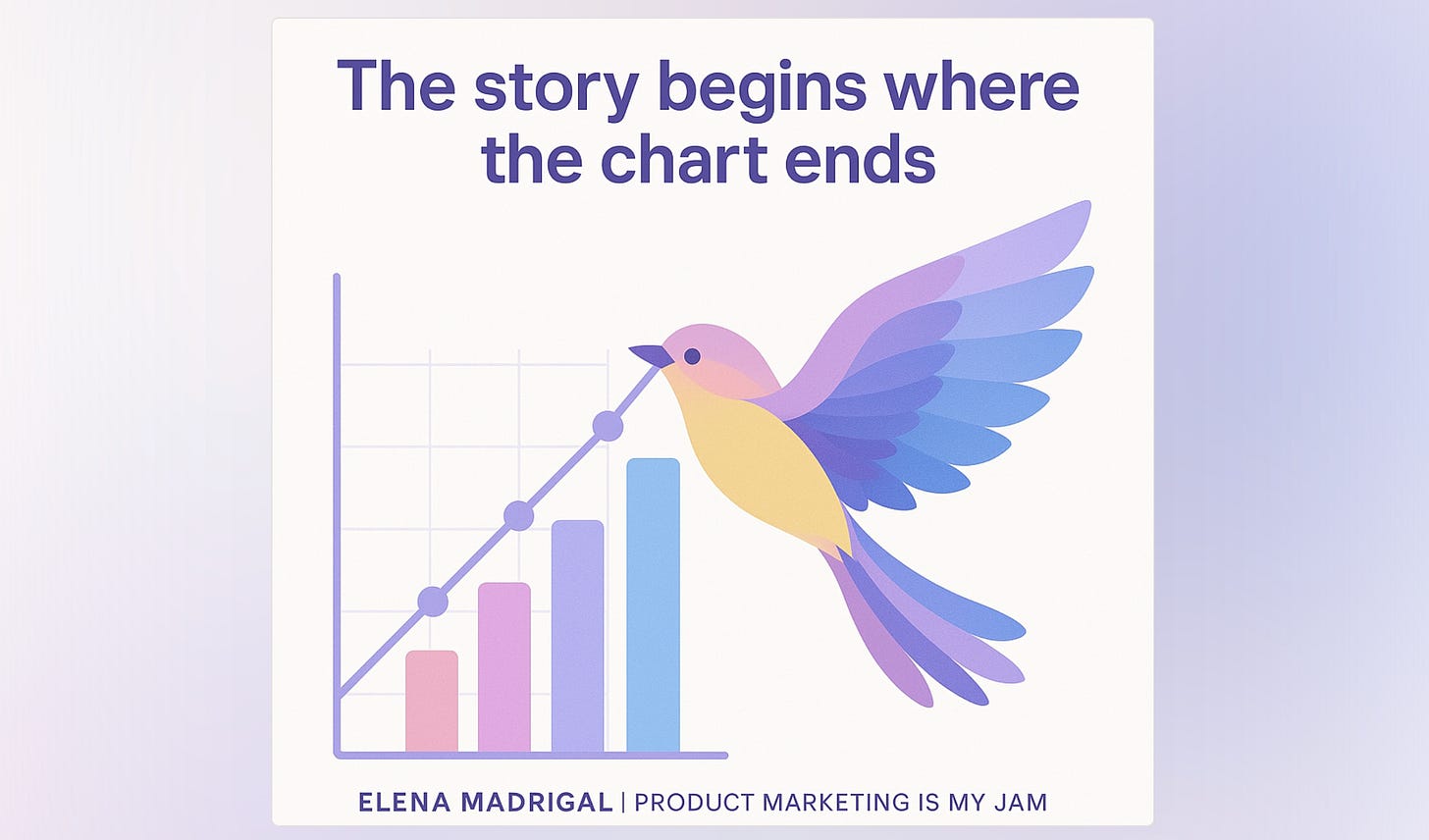How to Turn Metrics into Meaning
Why product marketers must go beyond dashboards and start telling intentional, emotional, data-driven stories

The Signal is the Story
There’s never been more data flying around… and somehow, it’s still hard to get the point across. It’s not about having the numbers, it’s about making them matter.
Product marketers sit at the crossroads of insight and communication. We are tasked with extracting truths from product usage, customer behavior, and market shifts, then distilling those truths into crisp, memorable narratives that drive adoption and advocacy.
But while we’ve grown more sophisticated with segmentation, measurement, and reporting, we often forget the most basic principle of persuasion:
People don’t remember facts. They remember stories.
This isn’t an abstract idea. It’s a neurological, behavioral, and strategic reality. And if product marketing is to remain relevant and resonant, we need to make storytelling, not just reporting, central to our craft.
We’re wired for stories, not spreadsheets
The human brain is a narrative machine. Research shows that when we hear stories, our brains don’t just process language, they simulate experience. Emotions. Motions. Sensations. In contrast, raw data triggers only a fraction of this response.
In short: data tells us what happened, but stories tell us why it matters.
For product marketers, this is the foundation of high-impact messaging:
A stat like “45% of users activated within the first week” may inform.
But a story like “Jess signed up on Monday and by Friday had already invited her entire design team. Just like 45% of our users do” will persuade.
Good stories don’t abandon data. They elevate it.

Storytelling is a structure, not just style
Too often, “storytelling” is dismissed as fluff, creative dressing on an otherwise dry report. But real storytelling is strategic. It follows a structure. It creates tension, movement, and resolution.
For product marketers, this structure mirrors the arc of a great GTM narrative:
The world before: Introduce the status quo, the challenge, the gap.
The catalyst: Something changes, an insight, a behavior, a shift.
The transformation: Show how your product (or feature) resolves that tension.
The new normal: What does life look like after adoption?
This structure isn’t just for case studies or campaign videos, it’s how you build launch messaging, nurture emails, and landing pages that resonate.
How to find the story inside your data
Every product marketer has access to rich data: usage logs, NPS scores, heatmaps, CS notes, funnel metrics. But most of us stop at analysis. We build dashboards. We annotate slides.
The story begins where the chart ends. But to get there, you must ask better questions:
What patterns are emerging that weren’t true a quarter ago?
What does this behavior suggest about user intent?
Where do successful users diverge from the rest?
What’s the emotional context behind this trend?
Imagine you’re looking at a dataset of Marvel characters. You could communicate the following:
“80% of Marvel characters are villains.”
Now, try to uncover narrative tension, a conflicting insight. For example, an insight that shows villains at a disadvantage compared to heroes. Let’s see:
“Villains are more common, but they die younger. Heroes are fewer, but they endure.”
That’s a brand-level insight dressed in data.
You can do the same with your own product:
Are free users racing through onboarding but ghosting before activation?
Are collaboration features creating stickiness in unexpected roles?
Are certain user types more loyal, but less visible?
These aren’t metrics. They’re stories waiting to be told.
Turning metrics into messaging: The KWY framework (aka the most letter soup-esque acronym ever)
To bridge the gap between insight and communication, apply the KWY framework:
KWYDIS – Know What Your Data Is Saying
Understand the signal, not just the stat. What does this metric really indicate about user behavior or need?KWYANTH – Know What Your Audience Needs to Hear
Translate findings into value propositions. How does this insight help them solve a problem or realize a goal?KWYRWTS – Know What You Really Want to Say
Define the narrative takeaway. What is the one thing you want your audience to remember or do?
Let’s apply this to a product adoption insight:
KWYDIS: Users who complete step 2 in onboarding are 4x more likely to upgrade.
KWYANTH: Most customers worry that setup will be a blocker.
KWYRWTS: Completing this one step dramatically boosts your success, and we’ve just made it 40% faster.
Now we’re telling a story, not citing a metric.
From visuals to vision: Designing narrative-driven assets
Even when your audience is scanning through a deck, a landing page, or an email, they’re absorbing structure. The strongest product narratives are supported by visual storytelling:
Annotated charts that call out the insight, not just the trend.
Metaphoric visuals (e.g. a “martini glass” arc) to guide user journey.
Narrative captions and labels that lead the eye and reinforce takeaway.
It’s not about being flashy. It’s about being clear. And clarity is the most persuasive force in a product marketer’s toolkit.
Practical applications: Where storytelling wins
Here are 3 places where data storytelling can transform product marketing:
1. Product launches
Instead of dumping feature specs, wrap your release in a before/after arc. Frame the feature as a moment of transformation.
2. Customer stories
Don’t just collect testimonials. Reconstruct the arc: challenge → discovery → usage → outcome → new reality.
3. Lifecycle campaigns
Tell stories that match journey stages. Data + narrative = urgency and relevance.
Your metrics are characters. Your product Is the plot.
Data storytelling isn’t about making things pretty. It’s about making things memorable, motivational, and meaningful.
As a product marketer, your job is not just to report on what the data shows, it’s to reveal what it means and why it matters.
So the next time you build a GTM plan or craft messaging for a new feature, don’t start with a dashboard. Start with a story.
Because in the end:
A chart can tell you what’s happening. But only a story can tell you what to do about it.




